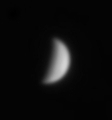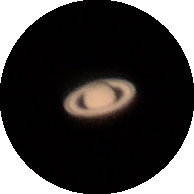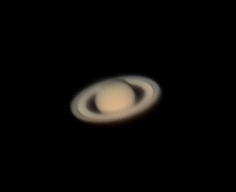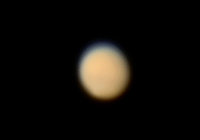iPhone Venus, Jupiter, Saturn, and Mars
Posted: 29 August 2018
|
Open: Tuesday, 28 August 2018, 1826 MST Temperature: 80°F |
Session: 1270 Conditions: Mostly clear |
Equipment Used:
12" f/8 LX600 w/StarLock
2" 24mm UWA eyepiece
2" 30mm eyepiece
2" 4X Powermate
Focal Reducer
Camera:
iPhone 8 Plus
D850 DSLR
1837 MST: LX600 ON, StarLock OFF, High Precision OFF.
Viewed Venus, 102X and 325X. Then mounted the iPhone 8 Plus for afocal 325X imaging of Venus. This is a stack of 2485 slo-mo (240fps) video frames (Camera app):

1854 MST: sunset (time approximate due to clouds).
Next, mounted the D850 DSLR at prime focus to acquire a "flat" image of the twilight sky for use in future post-processing. Also did a "flat" at prime focus + focal reducer.
1907 MST: viewed Jupiter, 325X. The four Galilean Moons were visible. Seeing was not good. Mounted the iPhone for afocal 325X imaging. This is a stack of 922 video frames (30fps) taken with NightCap Camera (ISO 100, 1/202sec):

1919 MST: saw and terminated a Kissing Bug. This was the first time I'd seen a Kissing Bug during the "Second Kissing Bug Season" of August-September. Normally I have seen them only May-June.
Slewed to Saturn and took this afocal 325X photo using NightCap Camera (ISO 320, 1/30sec):

This afocal 325X image is a stack of 922 video frames (30fps) taken with NightCap Camera (ISO 320, 1/30sec):

1930 MST: viewed Mars, 325X. Seeing was pretty bad due to thin clouds.
1939 MST: Kissing Bug #2 terminated.
1947 MST: seeing at Mars was a little better. This afocal 325X image is a stack of 922 video frames (30fps), NightCap Camera (ISO 100, 1/813sec):

1955 MST: ended planet imaging. Viewed Mars, 325X. The South Polar Cap and the North Polar Hood were visible. A faint (due to Martian dust) dark surface feature was barely visible.
Then mounted the D850 DSLR at prime focus + focal reducer. 2014 MST: Wi-Fi ON. Used SkySafari 6 Pro on the iPhone to GOTO NEO Asteroid 2016 NF23, Mag. +17.0, which was making its closest approach (about 3 million miles) to the Earth. 2017 MST: Wi-Fi OFF, StarLock ON. Took two StarLock autoguided, 5 minutes, ISO 6400, exposures. Unfortunately, during post-processing the asteroid was not visible. I have photographed much fainter asteroids, so perhaps there was a pointing error or thin clouds interferred.
2030 MST: eastern sky brightening from rising waning gibbous Moon.
2046 MST: LX600 OFF.
|
Close: Tuesday, 28 August 2018, 2058 MST Temperature: 76°F |
Session Length: 2h 32m Conditions: Mostly clear |
Last week we visited Lick Observatory in California. Click the link to see my report.
Comments are welcome using Email. Twitter users can use the button below to tweet this report to their followers. Thanks.
Cassiopeia Observatory Home Page
Copyright ©2018 Michael L. Weasner / mweasner@me.com
URL = http://www.weasner.com/co/Reports/2018/08/29/index.html
